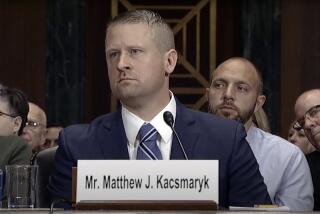Understanding Players on Both Sides of Issue
- Share via
SAN FRANCISCO — Her friends just couldn’t understand.
Over and over, Cynthia Gorney tried to explain why she had quit her job as a Style section reporter for the Washington Post: to write what she hoped would be the first balanced narrative history of abortion in America, sympathetically explaining the motives and actions of both sides in the wrenching controversy.
Gorney, who describes her own view of abortion at the beginning as that of “an ordinary adult female resident of Northern California,” was shocked to find that her liberal friends weren’t so liberal when it came to trying to understand the right-to-life movement. How can you talk to those people? friends asked.
“I was stunned,” she says. “I’ve interviewed murderers, spies, embezzlers, and no one ever said that to me before. I met far fewer crazies than the stereotype would have us believe. I was fascinated by the clash that was so intractable. We use the word ‘crazy’ to describe people whose strong beliefs don’t make sense to us and I think that word has gotten tossed around to great harm in this issue.”
To understand the worldview of a Catholic doctor she was writing about, she spent weeks in a theology library reading the same journals and books that the doctor would have read in school. “I wanted to understand his world,” she said. “I’m a fool for research--to the despair of every editor I’ve ever had.”
After six years of such labor, Gorney’s thick book, “Articles of Faith: A Frontline History of the Abortion Wars,” (Simon & Schuster) is out, published to coincide with today’s 25th anniversary of the Supreme Court’s Roe vs. Wade decision.
“An important and engaging work that should help further the conversation in constructive ways for both sides,” raved Publishers Weekly.
Gorney stumbled onto the subject in 1989 when an editor at the Washington Post Magazine asked her to write a piece about Webster vs. Reproductive Health Services, a Supreme Court case that threatened to overturn Roe vs. Wade. Gorney scoured libraries for background.
“I found religious theses, essay collections, sociological studies and medical texts,” she writes, “but I could not find a single volume that told me in narrative fashion what I wanted to know, which I began to understand was at once simple and alarmingly complex: How did we come to this? What were the stories of women and men whose personal understanding of the events around them was so different that they had come to describe these events in entirely different vocabularies?”
After some 500 interviews and many discoveries of documentary material that people pulled out of their attics for her, Gorney hopes she has written the book she was looking for.
“I didn’t want to write a tome. I wanted to write about human beings people could know and understand. What to leave out was the gigantic challenge. There is no single story that is the story; it’s not like the civil rights struggle where Martin Luther King is the story. There was no center.”
*
In the end, she returned to the beginning: St. Louis, where she focused on Judith Widdicombe, a nurse who runs an underground abortion service before the procedure is legalized and goes on to found the first legal abortion clinic in Missouri, and Samuel Lee, an aspiring seminarian who helps back the legal juggernaut that becomes Webster vs. Reproductive Health Services.
The book abounds in poignant detail: Widdicombe, in one graphic scene, has an illegal abortion performed without anesthesia and immediately afterward helps the doctor repeat the operation on a couple of other women.
While the main narrative unfolds from 1968 to 1989, Gorney sweeps back in time and space to tell the larger story of America’s agonizing experience with the abortion issue, showing how the tranquilizer Thalidomide and a rubella outbreak in the early 1960s set off widespread alarm about birth defects, spurring efforts to reform abortion law.
“It’s a story about conflicts in philosophy, law, theology, the ideas between the relationship of individuals and government, one’s feelings about men and women and God. It spans so many areas of American life,” Gorney says.
Gorney is sitting in her office in a leafy hillside neighborhood across the bay from San Francisco (she doesn’t want the city disclosed because she fears that her efforts to be even-handed might not satisfy some partisans). Pictures of her son and daughter, and her labor lawyer husband smile out from the chaos of the room. On the desk is a bouquet of flowers from the Center for Reproductive Law and Policy, which surprised Gorney because half of her book is given over to a sympathetic portrayal of the pro-choice group’s mortal enemies.
In moments of doubt, she would root around in her bookcase, rereading nonfiction classics that were both her muse and scold: “Simple Justice” by Richard Kluger, “Praying for Sheetrock” by Melissa Fay Greene or “Common Ground” by J. Anthony Lukas.
For Gorney, who grew up in San Francisco and spent 16 years at the Post, knowing so much about the abortion controversy only makes reaching conclusions more difficult. “I probably know less than anyone how it should be fixed,” she says. “You could put me on a stage and I could probably do a good job debating every position on this subject and with some passion.
“I came out feeling it’s infinitely more complex and I’m very grateful that I am a reporter and not a lawmaker. [Abortion] should not be criminalized but it should not be treated like removing a mole. We’ve made ambivalence a part of our feeling about this.”
More to Read
Sign up for our Book Club newsletter
Get the latest news, events and more from the Los Angeles Times Book Club, and help us get L.A. reading and talking.
You may occasionally receive promotional content from the Los Angeles Times.








